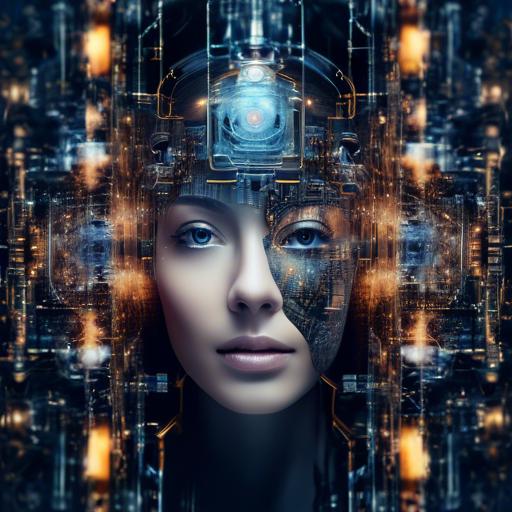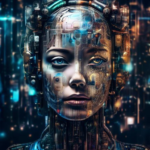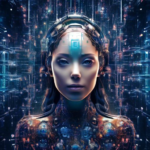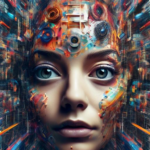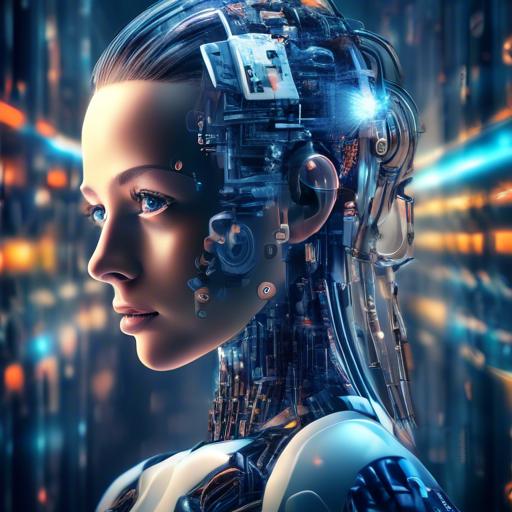In an age where creativity is both boundless and bewildering, the convergence of art and technology offers an exhilarating new frontier: artificial intelligence. Imagine a realm where your artistic vision is not limited by the strokes of your brush or the pixels of your screen, but where algorithms and innovation coalesce to enhance your creative prowess. Welcome to the revolutionary world of AI-driven image creation. Whether you’re a seasoned designer, a budding artist, or simply someone with a fervor for visual storytelling, this guide is here to support you every step of the way. We’ll explore how to seamlessly weave the wonders of AI into your image creation process, amplifying your imagination while retaining the essence of your unique artistic soul. Grab your virtual palette; your journey into the future of image creation begins now!
Table of Contents
- Understanding the Role of AI in Modern Image Creation
- Selecting the Right AI Tools for Your Needs
- Building a Seamless Workflow with AI Integration
- Mastering AI-powered Design Techniques
- Ensuring Quality Control with AI-enhanced Automation
- Boosting Creativity with AI-driven Inspiration
- Collaborating with AI: Enhancing Team Efficiency
- Overcoming Common Challenges in AI Integration
- Future Outlook
Understanding the Role of AI in Modern Image Creation
In the realm of visual artistry, AI is akin to a digital muse, amplifying the creative possibilities beyond traditional boundaries. Artificial intelligence has an astounding capability to analyze patterns, learn from vast datasets, and generate novel visuals that resonate with contemporary aesthetics. Integrating AI into your image creation process can remarkably enhance your workflow and your output’s ingenuity.
**Here’s how you can harness AI:**
- Smart Image Editing: Tools powered by AI can automate tedious tasks like background removal, object recognition, and color correction, leaving you more time to focus on the artistic aspects.
- Style Transfer: Implementing AI algorithms allows you to apply stylistic elements from one image to another, creating unique hybrid visuals that might be challenging to achieve manually.
- Generative Adversarial Networks (GANs): Use GANs to create entirely new images from scratch, offering unexplored creative spaces that traditional methods can’t provide.
Moreover, adopting AI in your creative toolkit doesn’t necessitate a steep learning curve. Many platforms provide **user-friendly interfaces** designed with creators in mind. For instance, tools like DALL-E and Artbreeder allow you to experiment with image generation through simple, intuitive controls.
| AI Tool | Primary Function |
|---|---|
| Photoshop AI Filters | Smart editing, background removal |
| DeepArt | Style transfer |
| Runway ML | Generative design, rapid prototyping |
Don’t forget the continuous evolution of AI technologies. Staying updated with the latest advancements ensures you can leverage the most innovative tools to redefine your creative process. While the human touch will always remain irreplaceable, AI serves as a powerful ally, pushing the boundaries of what’s possible and sparking new waves of creativity.
Selecting the Right AI Tools for Your Needs
Incorporating artificial intelligence into your image creation process can be both thrilling and overwhelming. To make the most of AI, it’s crucial to select the tools that align with your specific needs. Here are some considerations to guide your choice:
- Define Your Objectives: Are you focusing on enhancing image quality, generating entirely new images, or automating repetitive tasks? Knowing your primary goals will narrow down your options.
- Ease of Integration: Some AI tools are designed to seamlessly integrate with popular image-editing software like Adobe Photoshop, while others might require a standalone setup. Consider your current workflow to minimize disruptions.
- Scalability: As your projects grow, your AI tools should be able to scale accordingly. Look for options that offer flexibility to upgrade features as needed.
It’s also worth evaluating the **cost vs. benefits** of various AI tools. Some tools come with hefty subscription fees but offer comprehensive features, while others might be more budget-friendly but have limited capabilities. Here’s a quick comparison:
| Tool | Cost | Main Features |
|---|---|---|
| Tool A | $$$ | High-Quality Enhancements, Advanced Filters |
| Tool B | $$ | Automated Editing, AI-Assisted Design |
| Tool C | $ | Basic Enhancements, Easy Integration |
Consider **user reviews and community support** when making your decision. Forums, user groups, and reviews can provide invaluable insights into how well a tool performs and any potential drawbacks.
By taking into account the specific needs of your image creation projects, you can choose AI tools that not only streamline your workflow but also enhance the quality of your output. Whether it’s a high-end editor or a budget-friendly option, the right tool can make all the difference.
Building a Seamless Workflow with AI Integration
Integrating AI into your image creation process can revolutionize your workflow, making it more efficient and streamlined. With advancements in technology, AI tools can now assist you in every stage of image creation, from ideation to final polishing. Whether you’re a designer, illustrator, or content creator, leveraging these tools can significantly enhance your productivity and creativity.
One of the first steps is to identify the specific areas where AI can add value. Here are some common tasks where AI can play a critical role:
- Generating Ideas: Use AI-powered platforms to brainstorm creative concepts based on keywords or themes.
- Image Enhancement: Tools such as automatic image upscalers, color correctors, and noise reducers can help improve image quality with minimal effort.
- Design Assistance: AI can suggest layouts, typography, and color schemes that resonate well together.
To ensure a seamless workflow with AI integration, it’s essential to choose the right tools. Here are some popular AI tools and their core functionalities:
| Tool | Functionality |
|---|---|
| Adobe Sensei | Automated tasks in Photoshop and Lightroom |
| DeepArt.io | Transforms images into artworks using deep learning |
| Let’s Enhance | Upscales and enhances images without losing quality |
| Runway ML | Offers various AI-powered tools for creative projects |
| ColorMind | Generates color schemes based on AI |
Incorporating AI into your workflow doesn’t mean replacing your creativity; rather, it enhances it by automating repetitive tasks and offering new perspectives. Here are some tips for successful integration:
- **Start Small:** Begin with one or two tools to avoid feeling overwhelmed.
- **Train the AI:** Spend time training AI models with your specific preferences to get the best results.
- **Regular Updates:** Keep your AI tools up-to-date to leverage the latest features and improvements.
By thoughtfully integrating AI, you’ll not only speed up your image creation process but also open up new avenues for creativity, allowing you to produce high-quality work more efficiently.
Mastering AI-powered Design Techniques
Unlocking the potential of Artificial Intelligence (AI) in design is akin to discovering a new palette of creativity. **AI-powered design techniques** allow designers to transcend traditional boundaries, offering enhancements that streamline processes and inspire innovation. By seamlessly integrating AI, you can elevate your image creation process, ensuring a blend of efficiency and artistry.
Start with **automated tools** that use AI to generate design elements. Platforms leveraging these technologies can create multiple variations of a design in mere seconds. This not only saves time but also provides a rich reservoir of ideas that might have remained unexplored. Some pivotal AI tools you might consider include:
- **Generative Adversarial Networks (GANs)**: To create new, unique images based on existing datasets.
- **Deep Learning Algorithms**: For enhancing the quality of images, making them sharper and more detailed.
- **Style Transfer Tools**: That allow you to apply the style of one image to another.
**Collaboration between AI and human creativity** is where the magic truly happens. Rather than viewing AI as a replacement for human ingenuity, think of it as a collaborative partner. A designer can sketch an initial concept, which AI can then refine and enhance, leading to final creations that are a perfect blend of human emotion and machine precision. This synergy can be especially useful in creating mood boards, where AI can curate and suggest images that align with your thematic vision.
| Tool | Function | Benefit |
|---|---|---|
| GANs | Image Generation | Create unique variations |
| Deep Learning | Image Enhancement | Improves image quality |
| Style Transfer | Apply styles | Merge artistic elements |
Moreover, integrating AI into **feedback loops** facilitates rapid iterations. AI can quickly analyze user interactions and feedback, offering real-time insights into design effectiveness. This means you can adapt and tweak your designs based on actual data, ensuring they resonate well with your target audience.
Ensuring Quality Control with AI-enhanced Automation
Implementing AI in your image creation workflow can revolutionize how you maintain high-quality standards while streamlining the process. By utilizing machine learning algorithms, you can ensure that every image meets your pre-defined criteria and adheres to brand guidelines seamlessly.
- Automated Error Detection: AI algorithms can identify issues such as incorrect color balances, improper lighting, or even misplaced elements. These tools act as your vigilant eyes, catching errors that human review might miss.
- Consistency Across Projects: Establishing a uniform style becomes easier with AI-enhanced tools. They help maintain a cohesive look by ensuring that design elements align with your brand’s visual identity.
- Reduced Revision Cycles: By catching mistakes early on, AI reduces the number of revisions required, thus speeding up the entire creation process and improving productivity.
Here’s a snapshot of the advantages AI can bring to your image creation process:
| Feature | Benefit | Outcome |
|---|---|---|
| Real-time Feedback | Immediate error correction | Enhanced efficiency |
| Style Consistency | Uniform brand presence | Stronger brand identity |
| Predictive Analysis | Better decision-making | Improved design quality |
Moreover, AI can analyze vast datasets to predict trends and offer insights, allowing you to stay ahead in the competitive landscape. As it learns and evolves, AI can suggest innovations and improvements, ensuring that your image creation process is not just about maintaining quality but also about accelerating creativity and innovation.
Integrating AI into your image creation realm doesn’t mean replacing human creativity; rather, it’s about augmenting your creative toolkit. AI handles the repetitive, error-prone tasks, freeing you to focus on crafting stunning visuals that resonate with your audience.
Boosting Creativity with AI-driven Inspiration
One of the most remarkable ways AI is redefining the image creation landscape is through AI-driven inspiration. By integrating AI into your workflow, you can tap into an ever-expanding pool of creative ideas that may otherwise remain out of reach. Here’s how you can infuse AI into your creative process seamlessly.
- AI-based Mood Boards: Automate the compilation of mood boards using tools like Milanote or Canva with added AI capabilities. These platforms scour the internet for images matching your theme, bringing you a curated selection that aligns perfectly with your project’s needs.
- Smart Color Palettes: Leverage AI to suggest harmonious and trending color palettes, helping you break away from your usual schemes. Programs like Adobe Color and Colormind use AI to analyze and formulate color combinations that enhance the visual appeal of your creations.
- AI-powered Image Suggestions: Applications like Artbreeder and Deep Dream Generator utilize AI algorithms to morph, generate, and recommend images based on your input. This not only saves time but also introduces you to styles and concepts you might not have considered.
When it comes to integrating AI, another powerful application is **collaborative AI platforms**. These platforms bring together various AI tools under one roof, enabling you to blend different AI-generated elements into a cohesive creative output. These collaborative hubs can often integrate directly within image editing suites like Photoshop or Sketch, enhancing your design toolkit exponentially.
| Tool | Feature | Benefit |
|---|---|---|
| Artbreeder | Image Morphing | Create unique visuals by blending multiple images. |
| Colormind | Color Palettes | Discover unexpected yet stunning color schemes. |
| Adobe Color | Color Trend Analysis | Stay ahead with trending color combinations. |
To truly harness AI’s potential in your creative process, consider the **exciting practice of iterative design**. Use AI tools not just for the initial stages but throughout your project. For instance, after your initial design draft, employ AI to identify areas of improvement or suggest variations. This iterative feedback loop ensures your project evolves and refines continually.
Embracing AI-driven inspiration doesn’t mean replacing your creativity; it’s about enhancing it. With a multitude of innovative tools at your disposal, merging your original vision with the limitless possibilities AI offers can lead to extraordinary image creations that push boundaries and redefine artistic norms.
Collaborating with AI: Enhancing Team Efficiency
When integrating AI into your image creation workflow, it’s essential to see the technology as a teammate rather than just a tool. AI can dramatically boost team efficiency by automating tedious tasks and showcasing new creative avenues, allowing your team to focus on the high-impact parts of the project.
**Enhancing Brainstorming Sessions**:
- AI can **analyze trends** and generate mood boards, providing inspiration that aligns with current market preferences.
- Utilize AI-powered tools to produce **rough drafts and quick sketches** during brainstorming sessions, which helps streamline the initial stages of image conception.
- Encourage a **collaborative approach** where team members can adjust and refine AI-generated designs, adding a human touch to the final output.
**Optimizing Task Management**:
| Task | AI Tool Suggestions |
|---|---|
| Color Corrections | Adobe Sensei |
| Image Resizing | Let’s Enhance |
| Generating Thumbnails | Canva’s Magic Resize |
By leveraging AI for repetitive tasks like color corrections and resizing, designers can dedicate more time to the creative process.
**Automating Image Adjustments**:
- AI can **automatically adjust lighting and contrast** based on preset filters that match your brand’s style.
- Implement **smart cropping techniques** where AI identifies the focal points and adjusts the composition accordingly.
- Use AI for **background removal** to seamlessly integrate images into various design templates, saving hours of manual labor.
A seamless integration of AI can significantly reduce the overall time spent on tedious tasks, keeping your team motivated and focused on what truly matters—creativity and innovation.
Overcoming Common Challenges in AI Integration
Integrating AI into the creative process, particularly in image creation, can seem daunting at first. However, understanding and overcoming some common challenges can make the transition smoother. Let’s explore these obstacles and their solutions.
Lack of Technical Expertise: One of the primary hurdles is the perceived need for advanced technical skills. Fortunately, there are numerous user-friendly AI tools designed specifically for creatives. These platforms often come with drag-and-drop interfaces, step-by-step tutorials, and a vibrant community to support you.
Tools to Consider:
- Canva: Incorporates AI for enhancing images and suggesting design improvements.
- DeepArt: Uses neural networks to turn photos into stunning artworks.
- Runway ML: Provides an intuitive interface for a variety of machine learning models.
Data Privacy and Security: Another critical concern is ensuring data privacy and security. When relying on AI tools, it’s vital to choose software that complies with privacy regulations and has robust security measures. Regularly backing up your data and understanding the privacy policies of the tools you use can safeguard your creations.
Creative Control: A common fear among creators is losing their unique artistic touch. AI should be viewed as a co-creator rather than a replacement. Use AI-generated suggestions as a starting point and add your personal flair to make the final output truly yours.
| Challenge | Solution |
|---|---|
| Technical Expertise | Choose user-friendly AI tools |
| Data Privacy | Select compliant, secure software |
| Creative Control | Combine AI efficiency with personal touch |
Future Outlook
As you venture into the realm of AI-powered image creation, remember that the possibilities are endless and the tools are at your disposal. Embrace the technology, experiment fearlessly, and let your creativity soar to new heights. With AI as your ally, there is no limit to what you can achieve in the world of visual storytelling. So go ahead, dive in, and watch your creations come to life in ways you never thought possible. Your artistry knows no bounds with AI by your side. Happy creating!

